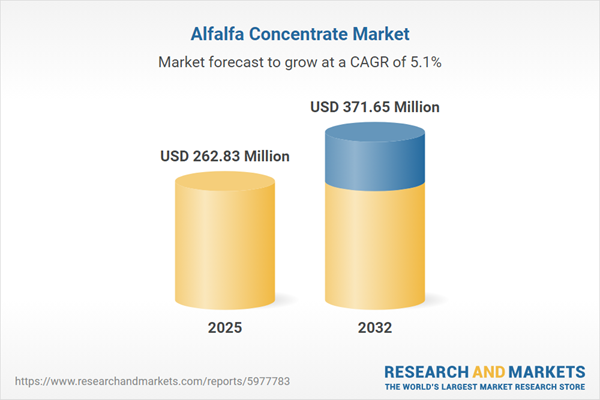Speak directly to the analyst to clarify any post sales queries you may have.
Senior executives operating in the alfalfa concentrate market face a landscape shaped by regulatory change, rapid technological progress, and elevated customer expectations. Sustained growth hinges on implementing resilient supply chain strategies, fostering organizational agility, and advancing sustainable practices that meet evolving global standards.
Market Snapshot: Alfalfa Concentrate Market Size and Growth
The global alfalfa concentrate market is projected to reach USD 249.97 million in 2024, forecasted to climb to USD 262.83 million in 2025, and further to USD 371.65 million by 2032, reflecting a CAGR of 5.08%. This trajectory is driven by demand from animal nutrition, health supplements, and wellness-centric industries. Leading firms are responding by enhancing their product portfolios, optimizing operations, and deploying digital technologies focused on customer needs. These strategies allow swift adaptation to sector regulations and emerging market priorities.
Scope & Segmentation for Senior Decision-Makers
This report offers actionable intelligence tailored for executives overseeing risk, market entry, and strategic growth in the alfalfa concentrate industry. Its segment-level insights reveal where investments can drive both compliance and innovation:
- Application: Sectors such as animal feed, cosmetics, dietary supplements, and pharmaceuticals each demand customized innovation, safety, and compliance across their value chains.
- Extraction Process: Technologies including drum drying, freeze drying, solar drying, and spray drying directly influence ingredient characteristics, operational flexibility, and alignment with global quality benchmarks.
- Distribution Channel: Strategies spanning direct sales, retail, wholesale, company outlets, and e-commerce are unlocking access to diverse client segments and enabling tailor-made market approaches.
- Form: Extruded, meal, pellet, and powder formats are supporting requirements for quality, supply chain optimization, and production adaptability.
- End User: Aquaculture, livestock, pet food, and poultry guide R&D investments while driving demand for differentiated formulations and application-specific solutions.
- Source: Choices between conventional and organic procurement influence sustainability positioning, procurement alignment, and attractiveness to key buyer groups.
- Region: North America, Latin America, Europe, Middle East, Africa, and Asia-Pacific represent diverse regulatory climates and infrastructure needs, shaping localized strategies for compliance and logistics efficiency.
- Company Coverage: Profiles of leaders such as Archer-Daniels-Midland Company, Cargill Incorporated, Bunge Limited, CHS Inc., Land O'Lakes Inc., Wilbur-Ellis Company, Scoular Company, Alltech Inc., Western Alfalfa Products Inc., and S&W Seed Company highlight their modernization and innovation initiatives.
Key Takeaways for Alfalfa Concentrate Market Leadership
- Diversifying into supplements and cosmetics sectors expands reach and helps balance exposure to market fluctuations.
- Adopting precision agriculture and digital monitoring enhances transparency and efficiency across the value chain, supporting compliance with both customer and regulatory expectations.
- Upgrading extraction and drying processes safeguards product quality and aligns with international requirements for safety and consistency.
- Pursuing organic certification and strengthening traceability support brand differentiation amid growing environmental and sourcing scrutiny.
- Collaborating with technology providers and research institutions empowers development of next-generation solutions and accelerates strategic responses to market needs.
- Expanding into e-commerce within traditional distribution models broadens customer access and supports agility in regions with complex logistics.
Tariff Impact on Alfalfa Concentrate Market Dynamics
Evolving U.S. tariff policies have impelled market participants to reassess global supplier networks and sourcing strategies. Efforts are underway to reinforce local value chains and upgrade logistics, enabling pricing flexibility and reinforcing competitive positions while sustaining reliable industry relationships.
Methodology & Data Sources
This market analysis synthesizes primary research with C-suite executives, extraction specialists, and regulatory authorities. Supplementary secondary research and detailed case studies provide a robust benchmark for strategic decision-making.
Why This Report Matters for Alfalfa Concentrate Market Leadership
- Clarifies regulatory changes and market transitions, supporting leaders as they plan data-driven strategies for navigating industry evolution.
- Enables the design of agile procurement and sustainability frameworks to enhance compliance and resilience across supply networks.
- Delivers actionable intelligence so executives can effectively manage complex supply chains and address cross-border challenges in a rapidly shifting environment.
Conclusion
Leaders who apply the insights from this report are positioned to achieve sustainable growth, greater operational flexibility, and ongoing relevance by prioritizing technology adoption, robust sourcing, and adaptive distribution in the evolving alfalfa concentrate market.
Additional Product Information:
- Purchase of this report includes 1 year online access with quarterly updates.
- This report can be updated on request. Please contact our Customer Experience team using the Ask a Question widget on our website.
Table of Contents
3. Executive Summary
4. Market Overview
7. Cumulative Impact of Artificial Intelligence 2025
Companies Mentioned
The companies profiled in this Alfalfa Concentrate market report include:- Archer-Daniels-Midland Company
- Cargill, Incorporated
- Bunge Limited
- CHS Inc.
- Land O'Lakes, Inc.
- Wilbur-Ellis Company
- Scoular Company
- Alltech, Inc.
- Western Alfalfa Products, Inc.
- S&W Seed Company
Table Information
| Report Attribute | Details |
|---|---|
| No. of Pages | 196 |
| Published | November 2025 |
| Forecast Period | 2025 - 2032 |
| Estimated Market Value ( USD | $ 262.83 Million |
| Forecasted Market Value ( USD | $ 371.65 Million |
| Compound Annual Growth Rate | 5.0% |
| Regions Covered | Global |
| No. of Companies Mentioned | 11 |









